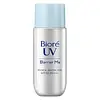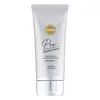What's inside
What's inside
 Key Ingredients
Key Ingredients

 Benefits
Benefits

 Concerns
Concerns

 Ingredients Side-by-side
Ingredients Side-by-side

Cyclopentasiloxane
EmollientZinc Oxide
Cosmetic ColorantHydrogenated Polyisobutene
EmollientTitanium Dioxide
Cosmetic ColorantButylene Glycol
HumectantDimethicone
EmollientNeopentyl Glycol Dicaprate
EmollientC12-15 Alkyl Benzoate
AntimicrobialTalc
AbrasivePEG-30 Dipolyhydroxystearate
EmulsifyingC30-45 Alkyldimethylsilyl Polypropylsilsesquioxane
Water
Skin ConditioningDipropylene Glycol
HumectantSorbitan Isostearate
EmulsifyingPotassium Hydroxide
BufferingGlycerin
HumectantPetrolatum
EmollientButyrospermum Parkii Butter
Skin ConditioningMethicone
EmollientStearic Acid
CleansingDextrin Palmitate
EmulsifyingBis-Vinyldimethicone Crosspolymer
EmollientParfum
MaskingCyclopentasiloxane, Zinc Oxide, Hydrogenated Polyisobutene, Titanium Dioxide, Butylene Glycol, Dimethicone, Neopentyl Glycol Dicaprate, C12-15 Alkyl Benzoate, Talc, PEG-30 Dipolyhydroxystearate, C30-45 Alkyldimethylsilyl Polypropylsilsesquioxane, Water, Dipropylene Glycol, Sorbitan Isostearate, Potassium Hydroxide, Glycerin, Petrolatum, Butyrospermum Parkii Butter, Methicone, Stearic Acid, Dextrin Palmitate, Bis-Vinyldimethicone Crosspolymer, Parfum
Tranexamic Acid
AstringentTocopheryl Acetate
AntioxidantWater
Skin ConditioningZinc Oxide
Cosmetic ColorantDipropylene Glycol
HumectantEthyl Polysilicate
Alcohol Denat.
AntimicrobialPropylene Glycol Dicaprate
EmollientPropylene Glycol Dicaproate
EmollientPolydiethylsiloxane
EmollientBis-Ethylhexyloxyphenol Methoxyphenyl Triazine
Skin Conditioning4-Hydroxybenzoic Acid
PreservativeHydrogenated Castor Oil
EmollientMethyl/Phenyl Polysilsesquioxane
Glycerin
HumectantPhthalic Anhydride
Sodium Stearic Acid Sulfate
EmulsifyingEel Extract
HumectantOrange Roughy Oil
Skin ConditioningChamomilla Vulgaris Extract
Skin ProtectingShilajit Extract
Sus Extract
Skin ConditioningTuna Extract
Skin ConditioningSodium Hyaluronate
HumectantHumulus Lupulus Extract
AntimicrobialWine Extract
AntioxidantYogurt Extract
Skin ConditioningCoix Lacryma-Jobi Ma-Yuen Seed Extract
Skin ConditioningCitrus Limon Fruit Extract
MaskingRosmarinus Officinalis Leaf Extract
AntimicrobialChamomilla Recutita Extract
Skin ConditioningButylene Glycol
HumectantIsohexadecane
EmollientIsopropyl Titanium Triisostearate
EmollientXanthan Gum
EmulsifyingSorbitan Fatty Acid Ester
EmulsifyingDi-T-Butylhydroquinone
AntioxidantCetearyl Alcohol
EmollientSodium Metabisulfite
AntioxidantBehenyl Alcohol
EmollientSteardimonium Ethyl Stearyl Phosphate
Skin ConditioningPhosphoric Acid
BufferingEthylhexyl Polyhydroxystearate
EmollientSorbitan Oleate
EmulsifyingAlcohol
AntimicrobialPhenoxyethanol
PreservativeTranexamic Acid, Tocopheryl Acetate, Water, Zinc Oxide, Dipropylene Glycol, Ethyl Polysilicate, Alcohol Denat., Propylene Glycol Dicaprate, Propylene Glycol Dicaproate, Polydiethylsiloxane, Bis-Ethylhexyloxyphenol Methoxyphenyl Triazine, 4-Hydroxybenzoic Acid, Hydrogenated Castor Oil, Methyl/Phenyl Polysilsesquioxane, Glycerin, Phthalic Anhydride, Sodium Stearic Acid Sulfate, Eel Extract, Orange Roughy Oil, Chamomilla Vulgaris Extract, Shilajit Extract, Sus Extract, Tuna Extract, Sodium Hyaluronate, Humulus Lupulus Extract, Wine Extract, Yogurt Extract, Coix Lacryma-Jobi Ma-Yuen Seed Extract, Citrus Limon Fruit Extract, Rosmarinus Officinalis Leaf Extract, Chamomilla Recutita Extract, Butylene Glycol, Isohexadecane, Isopropyl Titanium Triisostearate, Xanthan Gum, Sorbitan Fatty Acid Ester, Di-T-Butylhydroquinone, Cetearyl Alcohol, Sodium Metabisulfite, Behenyl Alcohol, Steardimonium Ethyl Stearyl Phosphate, Phosphoric Acid, Ethylhexyl Polyhydroxystearate, Sorbitan Oleate, Alcohol, Phenoxyethanol
Ingredients Explained
These ingredients are found in both products.
Ingredients higher up in an ingredient list are typically present in a larger amount.
Butylene Glycol (or BG) is used within cosmetic products for a few different reasons:
Overall, Butylene Glycol is a safe and well-rounded ingredient that works well with other ingredients.
Though this ingredient works well with most skin types, some people with sensitive skin may experience a reaction such as allergic rashes, closed comedones, or itchiness.
Learn more about Butylene GlycolDipropylene Glycol is a synthetically created humectant, stabilizer, and solvent.
This ingredient helps:
Dipropylene glycol is technically an alcohol, but it belongs to the glycol family (often considered part of the ‘good’ alcohols). This means it is hydrating and gentle on skin unlike drying solvent alcohols like denatured alcohol.
As a masking agent, Dipropylene Glycol can be used to cover the smell of other ingredients. However, it does not have a scent.
Studies show Dipropylene Glycol is considered safe to use in skincare.
Learn more about Dipropylene GlycolGlycerin is already naturally found in your skin. It helps moisturize and protect your skin.
A study from 2016 found glycerin to be more effective as a humectant than AHAs and hyaluronic acid.
As a humectant, it helps the skin stay hydrated by pulling moisture to your skin. The low molecular weight of glycerin allows it to pull moisture into the deeper layers of your skin.
Hydrated skin improves your skin barrier; Your skin barrier helps protect against irritants and bacteria.
Glycerin has also been found to have antimicrobial and antiviral properties. Due to these properties, glycerin is often used in wound and burn treatments.
In cosmetics, glycerin is usually derived from plants such as soybean or palm. However, it can also be sourced from animals, such as tallow or animal fat.
This ingredient is organic, colorless, odorless, and non-toxic.
Glycerin is the name for this ingredient in American English. British English uses Glycerol/Glycerine.
Learn more about GlycerinWater. It's the most common cosmetic ingredient of all. You'll usually see it at the top of ingredient lists, meaning that it makes up the largest part of the product.
So why is it so popular? Water most often acts as a solvent - this means that it helps dissolve other ingredients into the formulation.
You'll also recognize water as that liquid we all need to stay alive. If you see this, drink a glass of water. Stay hydrated!
Learn more about WaterZinc Oxide is a mineral broad-spectrum UV filter; it is the broadest UVA and UVB reflector approved by the FDA. It also has skin protectant and skin soothing properties.
Zinc oxide is one of the most effective broad-spectrum UV filters. It protects against UVB, UVAII, and UVAI. In comparison to its counterpart titanium dioxide, zinc oxide provides uniform and extended UVA protection.
Another great benefit? This ingredient is highly photostable so it won't degrade easily under sunlight.
A common myth is that mineral UV filters are widely believed to primarily reflect UV light.
However, modern research shows titanium dioxide absorbs UV radiation like chemical filters (~95% absorption & 5% reflection).
Zinc oxide has great skin soothing properties so you'll likely find this in sunscreens formulated for sensitive skin or babies/children. It is unlikely to cause "eye sting" like other sunscreen ingredients.
Regulatory agencies consider zinc oxide to be non-toxic and safe. It has also been shown to not penetrate the skin.
Unfortunately, this ingredient does leave a visible white cast. This is why mineral sunscreens are often less cosmetically elegant than chemical or hybrid ones.
In cosmetics, zinc oxide can be found in both non-nano and nano-sized forms. The nano version is used to reduce white cast and improve the texture of sunscreen formulas.
There are ongoing concerns surrounding nano-zinc oxide's impact on marine ecosystems and whether it can be absorbed into skin.
Regarding marine ecosystems and coral reefs, there is no conclusive evidence that any form of zinc oxide (or any other sunscreen ingredients) will cause harm. The science is still developing but many consumers are keeping a close eye on this issue.
Please note, many destinations have reef-safety sunscreen rules. For instance, the U.S. Virgin Islands advises all visitors to use non-nano mineral sunscreens.
There has also been some stir about whether micronized or nano zinc oxide has potential photoxicity and absorption through the skin/lungs.
An in-vitro (done in a test tube or petri dish) study demonstrated micronized zinc oxide to have potential phototoxicity. There's no need to fret; the EU Commission's Scientific Committee on Consumer Safety has stated, "The relevance of these findings needs to be clarified by appropriate investigations in vivo." Or in other words, further studies done on living organisms are needed to prove this.
Current research shows zinc oxide nanoparticles do not penetrate intact or sunburned skin. They either remain on the surface or in the outermost layer of dead skin (stratum corneum).
Zinc oxide is one of only two classified mineral UV filters with titanium dioxide being the other one.
Fun fact: Zinc has been used throughout history as an ingredient in paint and medicine. An Indian text from 500BC is believed to list zinc oxide as a salve for open wound. The Ancient Greek physician Dioscorides has also mentioned the use of zinc as an ointment in 1AD.
Learn more about Zinc Oxide